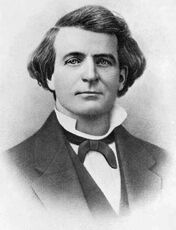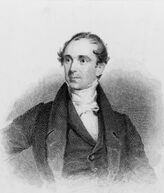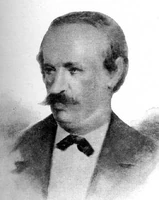
Hector Niles of California.
Hector Niles was the fourth President of the United States of Mexico, serving from September 1851 to September 1857.
1851 Election[]
Niles was a member of the Assembly from the state of California on 19 June 1851 when President Pedro Hermión was assassinated after delivering an address to the Mexican Congress. The Mexican Senate chose Senator Raphael Blaine of Arizona to serve as acting president until the upcoming 1851 Mexican elections.
The leading figure in the Liberty Party, former president Miguel Huddleston, was implicated in Hermión's death, and in any case had been reluctant to re-enter politics. The Libertarians were in danger of being held responsible for the assassination, and therefore proceeded cautiously in choosing their presidential nominee. The Libertarian caucus settled on Niles, who was believed to be a mild opponent of the Rocky Mountain War, but who had participated in few of the debates of the previous year. Niles was considered an economic expert, and had spent most of the war as head of a special committee in charge of armaments.
Niles prided himself on being a meticulous worker, a family man, and a good businessman. He said little during the election campaign except to pledge himself to end the war "in such a manner as to preserve our integrity and honor." The Continentalist Party nominated Blaine, who claimed that Hermión had been seeking peace at the time of his death, and that he would continue that effort. Blaine's assertion was clearly at odds with the warlike nature of Hermión's final address to Congress, and served only to convince Mexican voters that he was dishonest. In desperation, Blaine began to attack Niles as "The Faceless Wonder of San Francisco," and claim that Niles was "the best butterfly collector Mexico has ever seen, but this is no recommendation for the presidency."
The voters considered Niles to be better equipped to end the war than Blaine, and gave the Libertarians majorities in both houses of Congress, as well as in state-level elections. At his inauguration on 5 September 1851, Niles gave a short address in which he again pledged himself to end the war. He offered to meet Governor-General Henry Gilpin of the Confederation of North America "at a place of the Governor-General's choice, where we may end this sad conflict in good will."
Hague Treaty[]

Governor-General Henry Gilpin.
Niles ordered the Mexican army to cease all offensive operations and concentrate on defending territory already held. This meant abandoning the disputed Broken Arrow region, almost half of Mexico del Norte, and a small section of northern Jefferson to the North Americans. Gilpin ignored Niles' offer to negotiate, and instead regarded his defensive strategy as an admission of weakness.
Gilpin launched a series of offensives against the U.S.M., including an attempted landing on the Gulf coast of Durango, a naval attack on San Francisco, and in 1852 an assault on Williams Pass led by General Herkimer Ware which was defeated by Colonel Miguel Fernandez and Chief Brave Eagle. Mutinies in the field, uprisings in the Northern Confederation and Quebec, and a growing rejection of the war throughout the C.N.A. led to a rejection of Gilpin's government.
In the 1853 Grand Council elections, both North American parties nominated peace candidates. The National Conservative candidate, William Johnson of Manitoba, became governor-general in February 1853, and two months later he accepted Niles' offer to negotiate a peace agreement. Senator Frank Rinehart of Arizona met with Minister of War John Wolff of Indiana at The Hague, and the two arranged for an arbitration panel to meet in November to settle the outstanding issues of the war. In the meantime, an armistice began on 1 August 1853, with each army withdrawing ten miles to form a neutral zone than ran from the border of Russian Alaska to the Gulf of Mexico.
While the arbitration panel compiled its report, Niles ordered Secretary of Home Affairs Fidel Sonora to "make an inventory of assets and liabilities, to determine where we stand." Sonora was able to report that conditions were much better than was generally assumed. The war had mostly been fought in the thinly-populated areas of Arizona and Mexico del Norte, leaving the developed parts of Mexico barely touched. Sonora recommended federal aid only to the Indian tribes in those two states who had suffered most from the war. Most importantly, gold production in California had continued uninterrupted during the war. Since little had been shipped to Europe for sale, the reserves provided the U.S.M. with a source of reconstruction capital.
Under the terms of the panel's final report, which was issued on 15 June 1855, an area of Mexico del Norte would be ceded to the C.N.A., since it should have gone to North America under the 1799 Treaty of Aix-la-Chapelle, though Sobel states that this was a face-saving measure to allow Niles to claim that he had not surrendered any territory. In addititon, the North Americans would pay an indemnity of N.A. £2.5 million to compensate the U.S.M. for slaves that had fled across the border during the war, though Sobel claims that few slaves succeeded in escaping from the U.S.M., and that the indemnity was really for the loss of the disputed territory. No mention was made of the causes of the war, and blame for firing the first shot was not fixed. Both countries accepted the panel's findings, and the Hague Treaty was signed by Rinehart and Wolff on 7 August 1855.
Recovery[]

Benito Calzón of Durango.
When the terms of the treaty were announced, the Continentalist leader Benito Calzón denounced it as "the betrayal of the memory of Pedro Hermión," and claimed that Niles had "bartered away our birthright in Mexico del Norte for a questionable peace with a dastardly foe." So great were the recriminations against him that Niles feared leaving the Presidential Palace for fear of assassination attempts.
In spite of this, Niles attempted to restore the Mexican economy. He was able to secure long-term loans from the government of King Louis XIX of France at low interest rates. The combination of French loans, a revival of cotton exports from Jefferson, continued gold production, and the first dividends from President Andrew Jackson's agricultural development programs in Durango and Chiapas allowed the U.S.M. to return to its pre-war level of prosperity by 1858.
The Libertarian caucus renominated Niles in the 1857 Mexican elections, but he was unable to persuade Mexican voters that the Hague Treaty had been a reasonable peace. Governor Arthur Conroy of Arizona was able to capitalize on the idolization of the late Pedro Hermión to win a Continentalist majority in Congress, and Niles term came to an end with Conroy's inauguration on 5 September 1857.
Sources[]
Sobel's sources for the political career of Hector Hiles are Joseph Marro's In the Service of Mexico (Mexico City, 1871); David Marks' Hector Niles: The Mexican Augustus (Mexico City, 1949); Carlos McBride's The U.S.M. Elections of 1851: The End of an Era (Mexico City, 1960); Hector Corazón's La Vida y Obras de Benito Calzón de Durango (Mexico City, 1962); Frank Taft's The End of the War: The Hague in 1854-1855 (Melbourne, 1967); and Simon Rabbino's Except in His Native Land: The Irony of the Niles Presidency (London, 1970).
This is the Featured Article for the week of 26 January 2014.
| Heads of State of the U.S.M. |
|---|
| Andrew Jackson • Miguel Huddleston • Pedro Hermión • Raphael Blaine • Hector Niles • Arthur Conroy • Omar Kinkaid • George Vining • Benito Hermión • Martin Cole • Anthony Flores • Victoriano Consalus • Emiliano Calles • Pedro Fuentes • Alvin Silva • Felix Garcia • Vincent Mercator • Raphael Dominguez |
